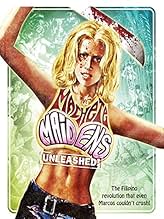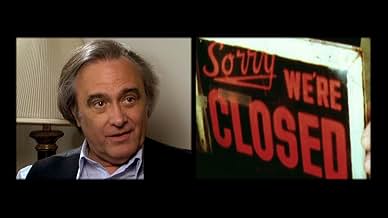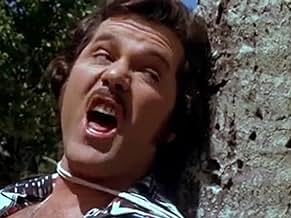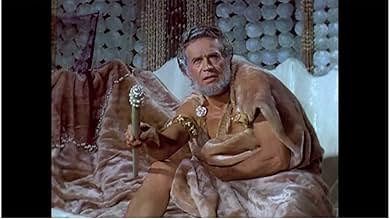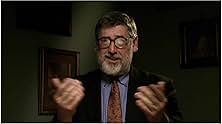NOTE IMDb
7,3/10
1,9 k
MA NOTE
Ajouter une intrigue dans votre langueA fast moving odyssey into the subterranean world of the rarely explored province of Filipino genre filmmaking.A fast moving odyssey into the subterranean world of the rarely explored province of Filipino genre filmmaking.A fast moving odyssey into the subterranean world of the rarely explored province of Filipino genre filmmaking.
- Réalisation
- Scénario
- Casting principal
Gerardo de Leon
- Self - Director
- (images d'archives)
Avis à la une
This documentary with it's (deliberately?) misleading title, gives viewers a brief overview of the Filipino cult cinema of the sixties, seventies and eighties. In a seemingly endless string of fragmented interviews (some of the edits so short that the subject's title is flashed for a fleeting moment), the film tries to draw an overview of this period of American/Filipino co-productions. Archival footage is interspersed here and there, and occasionally we are given context.
Is it interesting? Yes, but as much as it is frustrating. For you will certainly find that the film never settles down from its opening moments. The pace of the film is that of one tempo, as if the editor was worried that we might lose interest, or as if the visual information was paramount and the factual information (something I'm more interested in than anecdotal) was a mere triviality. You will be bombarded with cuts and clips and cues for the duration of the film - it's an editing style borne from the free-to-air TV realm that transposes to the cinema with a terrible effect.
Also, the relentless funk soundtrack (the staple to the C-Grade Grindhouse films) undermined the interviewees' comments, robbing them of any memorable moment and washing them altogether with the same colour. I can't help but relate the style of this documentary with American style 20-to-1 type shows, where the interviewees are there to provide colour to a proposed topic, not to provide any real insight. This is the films worst crime, for Filipino film-makers we are shown are outnumbered five-to-one by the Americans, yet the tiny grabs we are given with these eccentric characters were far more interesting and exotic.
This film belongs on a commercial or pay TV network, but the limited audience and scope of the film will probably condemn it to the Australian Broadcasting Corporation's schedule sometime in the near future. Wait for it then, for the cinema gives little to this difficult documentary.
Is it interesting? Yes, but as much as it is frustrating. For you will certainly find that the film never settles down from its opening moments. The pace of the film is that of one tempo, as if the editor was worried that we might lose interest, or as if the visual information was paramount and the factual information (something I'm more interested in than anecdotal) was a mere triviality. You will be bombarded with cuts and clips and cues for the duration of the film - it's an editing style borne from the free-to-air TV realm that transposes to the cinema with a terrible effect.
Also, the relentless funk soundtrack (the staple to the C-Grade Grindhouse films) undermined the interviewees' comments, robbing them of any memorable moment and washing them altogether with the same colour. I can't help but relate the style of this documentary with American style 20-to-1 type shows, where the interviewees are there to provide colour to a proposed topic, not to provide any real insight. This is the films worst crime, for Filipino film-makers we are shown are outnumbered five-to-one by the Americans, yet the tiny grabs we are given with these eccentric characters were far more interesting and exotic.
This film belongs on a commercial or pay TV network, but the limited audience and scope of the film will probably condemn it to the Australian Broadcasting Corporation's schedule sometime in the near future. Wait for it then, for the cinema gives little to this difficult documentary.
A fast moving odyssey into the subterranean world of the rarely explored province of Filipino genre filmmaking.
I love horror films and exploitation films and consider myself both a critic and historian (having now reviewed over 2000 films and written numerous articles). Yet, I must confess, I was not aware of the hundreds -- perhaps thousands -- of films that were made in the Philippines. I knew about some of them, of course, but did not know just how huge the output was.
Wow! This is one of the best documentaries I have ever seen on exploitation films (and I have seen my share). John Landis never disappoints, and some unusual suspects show up, too. R. Lee Ermey? Who knew?
I love horror films and exploitation films and consider myself both a critic and historian (having now reviewed over 2000 films and written numerous articles). Yet, I must confess, I was not aware of the hundreds -- perhaps thousands -- of films that were made in the Philippines. I knew about some of them, of course, but did not know just how huge the output was.
Wow! This is one of the best documentaries I have ever seen on exploitation films (and I have seen my share). John Landis never disappoints, and some unusual suspects show up, too. R. Lee Ermey? Who knew?
I watched a couple of women-in-prison movies the other day. Both were made in the Philippines. This documentary goes behind the scenes to show why and how Roger Corman type films were made there. Cheap actors and lax safety rules made for an ideal situation for making low budget films.
Blood, breasts, and beasts were the staples of films like Mad Doctor of Blood Island, Beast of Blood, The Big Doll House, Women in Cages, Black mama, White Mama,The Big Bird Cage, and the classic Vampire Hookers.
We see stars like Pam Grier learning the craft in these cheap films. Part of a new wave of women as action heroes, which was new to moviegoers.
The documentary was invaluable in understanding the background of filmmaking.
Blood, breasts, and beasts were the staples of films like Mad Doctor of Blood Island, Beast of Blood, The Big Doll House, Women in Cages, Black mama, White Mama,The Big Bird Cage, and the classic Vampire Hookers.
We see stars like Pam Grier learning the craft in these cheap films. Part of a new wave of women as action heroes, which was new to moviegoers.
The documentary was invaluable in understanding the background of filmmaking.
Directed by Mark Hartley, the man behind Electric Boogaloo: The Wild, Untold Story of Cannon Films, comes Machete Maidens Unleashed. It's a fast moving but pretty informative look at exploitation films in the late 60's, 70's and early 80's. It's main focus is to give explanation about the wild films that came out from the Philippines. Many of the B movie staples came from this era of film. It spans about 15 years where these films were all the rage at Drive-Ins and the rules didn't apply.
The film starts off with showing how production moved from the states to the Philippines after it was liberated by America. The country was very American friendly. Gerry de Leon and Eddie Romero were the first filmmakers to establish themselves and start making films. The first focus was on the Blood Island films of which there were a few. It's funny to hear the filmmakers talk about these films while clips are show. The films were goofy horror movies shot on shoestring budgets with thin plots and bad acting. What brought people to these films were the shocks promised from the trailers. There would be gore, obviously fake gore but monsters, science fiction and terror.
Roger Corman is introduced as producer as his time line crosses with that of Eddie Romero. Corman was a bigger name and he had lofty aspirations. Most of the 'hit' films being produced by him. The montage of what he was known for is hilarious. There's also a montage of all of the elements in a good Corman movie. Having not seen many of his film, it was interesting that he wanted to make the 'best' film with the money he had.
But the films out of this area Corman is known for where highlighted in a feature on women in prison film. These films were actually highly successful because of the way they portrayed women as the heroes. Even though they were meant to titillate and entertain, the films helped the up and coming feminist movement. There are interviews with many of the famous actress such as Pam Grier, Colleen Camp, Judith Brown, Leigh Christian & Gloria Hendry. They were put through the ringer. The interviews are the most fascinating here. There are first hand accounts of what the actresses had to go through. Some of the things they went through will be shocking but not against the times.
Sig Haig gives insight on what he had to go through in these films as well. Being that all these films were R-rated or not rated at all, it was refreshing to see the clips in all their uncensored glory. I would hate to watch a PG-13 version of this film. It wouldn't give the films their shock credit. There are ample amounts of nudity and bloody violence. The highlight of all the interviews is many of the moments with John Landis. He provides uncensored thoughts which are insightful and laugh out loud funny. I could have seen all the uncut footage from his interviews. I know there was more great commentary from the director.
In the middle of the 70's the blaxploitation films were all the rage. Two of the films that led the charge came out Phillippines. Cirio H. Santiago directed TNT Jackson, which many of the actors talked about. It was a film that mixed Kung Fu with full on action and had a black female lead. This section of the documentary is most about the late 70s mixing of martial arts in the B-movie era. The stunt work is highlighted as most of the actors did all their own stunts. And the extra were on board for doing anything. Many were injured and a few died. But it was the idea of being in a 'big' Hollywood film that tested people's limits. A small portion of the film is devoted to Francis Ford Coppola whose Apocalypse Now is infamous for it's filming in Philippines. It's only give a few minutes in the documentary but enough is shown that made me want to dive into Heart of Darkness.
The final stretch of the film speaks about Manila International Film Festival and the growing film market. Jaws and Star Wars are targeted as B-movies that were made on a A-level. With these films the decline of the Philippine cinema began. The final big success was the James Bond type spoof starting homegrown Weng Weng. It was the last hit of this era of B-movie cinema. This documentary was so insightful and entertaining. I wasn't bored for a minute. Given that it is unrated also help. So much footage was shown that I was intrigued to see some of these films as a whole. To my surprise, Netflix does carry many of these films. I can see a B-movie marathon in my future.
The film starts off with showing how production moved from the states to the Philippines after it was liberated by America. The country was very American friendly. Gerry de Leon and Eddie Romero were the first filmmakers to establish themselves and start making films. The first focus was on the Blood Island films of which there were a few. It's funny to hear the filmmakers talk about these films while clips are show. The films were goofy horror movies shot on shoestring budgets with thin plots and bad acting. What brought people to these films were the shocks promised from the trailers. There would be gore, obviously fake gore but monsters, science fiction and terror.
Roger Corman is introduced as producer as his time line crosses with that of Eddie Romero. Corman was a bigger name and he had lofty aspirations. Most of the 'hit' films being produced by him. The montage of what he was known for is hilarious. There's also a montage of all of the elements in a good Corman movie. Having not seen many of his film, it was interesting that he wanted to make the 'best' film with the money he had.
But the films out of this area Corman is known for where highlighted in a feature on women in prison film. These films were actually highly successful because of the way they portrayed women as the heroes. Even though they were meant to titillate and entertain, the films helped the up and coming feminist movement. There are interviews with many of the famous actress such as Pam Grier, Colleen Camp, Judith Brown, Leigh Christian & Gloria Hendry. They were put through the ringer. The interviews are the most fascinating here. There are first hand accounts of what the actresses had to go through. Some of the things they went through will be shocking but not against the times.
Sig Haig gives insight on what he had to go through in these films as well. Being that all these films were R-rated or not rated at all, it was refreshing to see the clips in all their uncensored glory. I would hate to watch a PG-13 version of this film. It wouldn't give the films their shock credit. There are ample amounts of nudity and bloody violence. The highlight of all the interviews is many of the moments with John Landis. He provides uncensored thoughts which are insightful and laugh out loud funny. I could have seen all the uncut footage from his interviews. I know there was more great commentary from the director.
In the middle of the 70's the blaxploitation films were all the rage. Two of the films that led the charge came out Phillippines. Cirio H. Santiago directed TNT Jackson, which many of the actors talked about. It was a film that mixed Kung Fu with full on action and had a black female lead. This section of the documentary is most about the late 70s mixing of martial arts in the B-movie era. The stunt work is highlighted as most of the actors did all their own stunts. And the extra were on board for doing anything. Many were injured and a few died. But it was the idea of being in a 'big' Hollywood film that tested people's limits. A small portion of the film is devoted to Francis Ford Coppola whose Apocalypse Now is infamous for it's filming in Philippines. It's only give a few minutes in the documentary but enough is shown that made me want to dive into Heart of Darkness.
The final stretch of the film speaks about Manila International Film Festival and the growing film market. Jaws and Star Wars are targeted as B-movies that were made on a A-level. With these films the decline of the Philippine cinema began. The final big success was the James Bond type spoof starting homegrown Weng Weng. It was the last hit of this era of B-movie cinema. This documentary was so insightful and entertaining. I wasn't bored for a minute. Given that it is unrated also help. So much footage was shown that I was intrigued to see some of these films as a whole. To my surprise, Netflix does carry many of these films. I can see a B-movie marathon in my future.
Starting from the the 1950's war pictures and ending in 1980, this documentary covers films made in the Philippines but made for American audiences or exported to America. Bomba films are not covered as they were not exported.
Interviewed are actors, actresses, directors, producers directly involved in these films or occasionally their relatives. Director John Landis curiously appears several times but I'm not aware of any involvement he had with Filipino filmmaking.
They go thru a host of low budget films, that used the Philippines location as they explain in detail was cheap. It is those particular details plus explaining the evolving political situation that steps this documentary up a few notches. Besides the films, some directors including Cirio Santiago, Bobby Suarez & others even explaining their styles & approach to the films. This is important as they influenced American filmmakers, notably Quentin Tarantino who were fans. Even Apocalypse Now was talked about.
They really stuffed a lot of related subjects and insights into this documentary. I also liked how they sometimes edited parts of interviews together as if the next person was responding to the previous one. It does help if you know or interested in filmmaking itself as that's the main focus. As a huge film buff, I was fascinated from beginning to end.
Interviewed are actors, actresses, directors, producers directly involved in these films or occasionally their relatives. Director John Landis curiously appears several times but I'm not aware of any involvement he had with Filipino filmmaking.
They go thru a host of low budget films, that used the Philippines location as they explain in detail was cheap. It is those particular details plus explaining the evolving political situation that steps this documentary up a few notches. Besides the films, some directors including Cirio Santiago, Bobby Suarez & others even explaining their styles & approach to the films. This is important as they influenced American filmmakers, notably Quentin Tarantino who were fans. Even Apocalypse Now was talked about.
They really stuffed a lot of related subjects and insights into this documentary. I also liked how they sometimes edited parts of interviews together as if the next person was responding to the previous one. It does help if you know or interested in filmmaking itself as that's the main focus. As a huge film buff, I was fascinated from beginning to end.
Le saviez-vous
- AnecdotesAll the footage of Quentin Tarantino interviewing Cirio H. Santiago had to be cut from the final finished version of the film.
- ConnexionsFeatured in Kain's Quest: The Arena (2017)
- Bandes originalesLet's Go Where the Action Is
Written and Performed by Tommy Boyce and Bobby Hart
Meilleurs choix
Connectez-vous pour évaluer et suivre la liste de favoris afin de recevoir des recommandations personnalisées
- How long is Machete Maidens Unleashed!?Alimenté par Alexa
Détails
- Date de sortie
- Pays d’origine
- Sites officiels
- Langue
- Aussi connu sous le nom de
- Machete Maidens Unleashed!
- Lieux de tournage
- Sociétés de production
- Voir plus de crédits d'entreprise sur IMDbPro
- Durée
- 1h 24min(84 min)
- Couleur
- Rapport de forme
- 1.78 : 1
Contribuer à cette page
Suggérer une modification ou ajouter du contenu manquant


